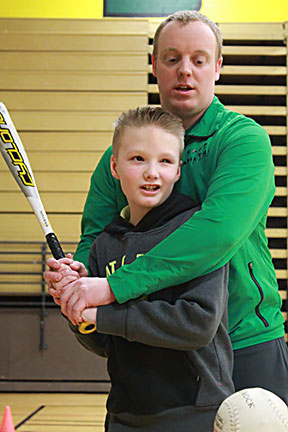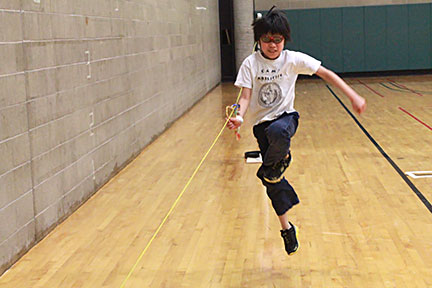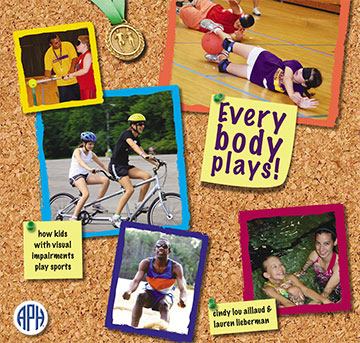Future Reflections Special Issue, Extracurricular Activities PROGRAMS
Camp Abilities
A Sports Camp for Children with Visual Impairments
by Lauren J. Lieberman
From the Editor: "This game is too rough for you. They're throwing a ball around, and you won't know where it is. You better sit this one out." Blind and visually impaired children hear such warnings all too often at school, in after-school activities, and at the park. With a few simple adaptations, however, blind children can play most sports and active games. Physical activity is just as important for blind children as it is for their sighted peers—and it's just as much fun!
 In general, blind and visually impaired children have been shown to be less physically active than their sighted peers. They often exhibit deficits in gross motor skills such as running, galloping, sliding, throwing, kicking, and batting. The reasons for these deficits are complex, but limited opportunities and lack of knowledge on the part of physical educators and caregivers are important contributing factors. One way to help blind and VI children develop their physical potential is to expose them to a variety of sports. Another way is to educate teachers about the capabilities of students with visual impairments. Camp Abilities was created to do both.
In general, blind and visually impaired children have been shown to be less physically active than their sighted peers. They often exhibit deficits in gross motor skills such as running, galloping, sliding, throwing, kicking, and batting. The reasons for these deficits are complex, but limited opportunities and lack of knowledge on the part of physical educators and caregivers are important contributing factors. One way to help blind and VI children develop their physical potential is to expose them to a variety of sports. Another way is to educate teachers about the capabilities of students with visual impairments. Camp Abilities was created to do both.
Camp Abilities is a developmental sports camp model for children and adolescents who are blind, visually impaired, or deaf-blind. With my colleague, Dr. Monica Lepore, I founded the camp in 1996 at the College at Brockport, State University of New York. The first camp served twenty-seven athletes and included thirty volunteer coaches. To date, the program has served more than two thousand athletes at over twenty-two locations across the United States and abroad (Canada, Costa Rica, Finland, Ireland, and Portugal). Each camp shares a similar structure and mission with the original Camp Abilities, while adding unique features specific to the geographic locality. In order to find the camp closest to you, look under "other camps" at our main website, <www.campabilities.org>.
Camp Abilities is built upon the premise that instruction in a variety of physical activities and sport experiences improves the lives of blind, visually impaired, and deaf-blind students. Camp Abilities offers after-school sports and Paralympic sports as well as recreational activities. Sports with formal instruction include, but are not limited to, beep baseball, goalball, track and field, swimming, tandem cycling, judo, self-defense, and gymnastics. During free time, kayaking, canoeing, stand-up paddle boarding, fishing, horseback riding, rock climbing, rollerblading, basketball, beep kickball, and dancing are available.
The activities at Camp Abilities are integral to the camp's main purposes. Our first goal is to empower students with visual impairments to be physically active members of their communities. Our second goal is to train pre-service teachers from a variety of fields to teach physical activities to students with visual impairments. Finally, we strive to educate parents. At the beginning of camp we spend a lot of time training the parents, and we provide them with a big folder of resources at the end. Camp Abilities fulfills its purposes by providing high quality teaching, a one-on-one camper to counselor ratio, and access to blind and visually impaired role models.
 During the week of Camp Abilities, campers are assessed on their process of performance and the product of their performance in each major sport. The counselors are pre-service teachers who undergo a ten-hour orientation over two days prior to the arrival of the campers. During the week of camp, counselors complete process and product assessments. The assessment is sent home to help the parents learn what their children can do. Parents are encouraged to share assessments with the children's physical education teachers.
During the week of Camp Abilities, campers are assessed on their process of performance and the product of their performance in each major sport. The counselors are pre-service teachers who undergo a ten-hour orientation over two days prior to the arrival of the campers. During the week of camp, counselors complete process and product assessments. The assessment is sent home to help the parents learn what their children can do. Parents are encouraged to share assessments with the children's physical education teachers.
At Camp Abilities the children are exposed to highly accomplished blind and visually impaired role models. Among the athletes who have come to camp are Jim Mastro, a 7X Paralympian in judo and track and field; Peter Gottwald, a silver medalist in track; Asia Miller and Jennifer Armbruster, gold medal goalball players; Cody Colchado, a national champion in power lifting; Kris Scheppe, a world champion sailor; and Trischia Zorn, the winningest Paralympian in the world, with forty-one medals in swimming. It is very important for blind and visually impaired children to have role models they can learn from and admire.
The Camp Abilities staff helps members of the community learn about and support youth with visual impairments. Lions Clubs assist with funding, meals, transportation, and overall setup. Through their involvement with the camps, club members have the opportunity to see what the children can do. Once children learn a sport at camp, they often get actively involved in school and community sports back home. The more active the children become, the farther they spread the message about the athletic abilities of blind and visually impaired people.
Resources
Physical education programs for blind and visually impaired children require funding for electronic equipment, educational materials, and products necessary for specific instruction. The American Printing House for the Blind (APH) is a government-funded agency that sells specialized equipment and educational materials. Some of the cost of these items can be defrayed by Quota Funds, which are available to parents and teachers through the child's school district. To access these products contact your child's teacher of the visually impaired or orientation and mobility instructor. (See "APH Quota Funds: How to Access Free Educational Materials for Blind and Deaf-blind Students," Future Reflections, Summer 2013, <https://nfb.org/images/nfb/publications/fr/fr32/3/fr320315.htm>
Table 1: Physical Activity Products from The American Printing House for the Blind
Name of the Product |
Description |
Sound Balls |
Hard foam sound balls in red or yellow that can be used universally in most ball sport units |
Jump Rope Kit |
Kit that comes with a rope-less jump rope, beaded jump ropes, plastic jump ropes, a foam mat to jump on and a manual to help the child learn how to jump rope |
30-Love Tennis Kit |
A tennis kit that comes with foam tennis balls, two racquets, blindfolds, and a tennis manual with rules of the game and modifications |
Walk-Run for Fitness Kit |
A kit that promotes walking and running. It comes with two talking pedometers, a guidewire, a tether, and a manual to teach children what to wear, how to use the different guide running techniques, advocacy, etc. |
Sport Court: Touch & Play |
A kit that provides 13 different tactile fields and courts. It includes a manual that describes each sport, the history, rules, instructional modifications, equipment modifications, and strategies for teaching children who are both deaf and visually impaired or blind. |
Everybody Plays! book |
This is a book for children in third to fifth grades that describes how children with visual impairments can play a variety of different sports. It opens with a forward by Erik Weihenmayer, and ends with advice from elite athletes. |
Games for People with Sensory Impairments book |
This book is for parents and physical education teachers. It has a very long list of sports and games with specific modifications for children with visual impairments as well as children with multiple disabilities or deafblindness |
Going Places book |
This book is a transition guide for adolescents with visual impairments from 14 to 21 years of age. It provides a curriculum to help these young adults decide what sports and recreational activities they would want to do when they graduate from school. It also provides extensive information on role models and advocacy approaches. |
Every product comes in large print, audio, and Braille versions depending on the child’s needs. See APH.org and go to physical education and click on the products button.
Below are some additional resources.
Books
 Aillaud, C., and Lieberman, L.J. (2013) Everybody Plays! How Children with Visual Impairments or Deafblindness Play Sports. Louisville, KY: American Printing House for the Blind.
Aillaud, C., and Lieberman, L.J. (2013) Everybody Plays! How Children with Visual Impairments or Deafblindness Play Sports. Louisville, KY: American Printing House for the Blind.
LaCatorglia, M. (2009) Run, Play, Move. Watertown, MA: Perkins School for the Blind.
Leibs, A. (2013) The Encyclopedia of Sport and Recreation for People with Visual Impairments. Charlotte, NC: Information Age Publishing.
Lieberman, L.J., and Cowart, J. (2011) Games for People with Sensory Impairments (2nd ed.). Louisville, KY: American Printing House for the Blind.
Lieberman, L.J., Modell, S., Jackson, I. (2006) Going Places: A Transition Guide to Physical Activity for Youth with Visual Impairments. Louisville, KY: American Printing House for the Blind.
Lieberman, L.J., Haibach, P. (in press) Motor Development for Children with Visual Impairments. Louisville, KY: American Printing House for the Blind.
Lieberman, L.J., and Houston-Wilson, C. (2009) Strategies for Inclusion: A Handbook for Physical Educators, (2nd ed). Champaign, IL: Human Kinetics.
Lieberman, L.J., Ponchillia, P., and Ponchillia, S. (2013) Physical Education and Sport for Individuals Who Are Visually Impaired or Deafblind: Foundations of Instruction. New York, NY: American Foundation for the Blind Press.
Schedlin, H., and Lieberman, L.J. (2011) Sports for Everyone: A Handbook for Starting Sports Camps for Children with Visual Impairments. Watertown, MA: Perkins Publishing.
Assessment
Winnick, J.P., and Short, F.X. (2014) The Brockport Physical Fitness Test. Champaign, IL: Human Kinetics. -- Health related fitness test for children with visual impairments ages 10-17
Video
<http://www.aph.org/pe/Motor-Video-Feedback.html> -- A video on how to teach motor skills to children with visual impairments.
Websites
<http://rousettus.com/products/?gclid=CIi0-45zpKECFddR2godSXZlvw> -- Yoga mat with Braille and raised shapes for positioning plus an instructional DVD.
<www.Braillegifts.com> -- bell soccer balls and basketballs
<www.seegreatthings.com> -- Goalball kits from the Association for the Blind and Visually Impaired, Rochester
<www.beepkickball.com> -- Provides rules for beep kickball as well as a place to purchase beep kickballs
<www.Flaghouse.com> -- Audible balls and other equipment
<www.costore.com/qwestpioneers/welcome.asp> -- Beep baseballs
<www.glowproducts.com> -- Everything that glows, including frisbees
<www.Independentliving.com> -- Beeping volleyballs, basketballs, and soccer balls
<www.campabilities.org> -- Information about Camp Abilities as well as teaching strategies for blind, visually impaired, and deaf-blind children
<www.twu.edu/INSPIRE> -- Information about adapted physical education for all children
<www.tsbvi.edu/recc/pe.htm> -- Resources and published material related to physical education and sports for children with visual impairments from the Texas School for the Blind and Visually Impaired
<www.usaba.org> -- Information about the United States Association for Blind Athletes, our national governing body for sports for visually impaired, blind, or deaf-blind individuals. It includes a link to game modifications for children.
<http://www.us-games.com> -- Great equipment.
<www.disabledsportsusa.org> -- Modifications to sports and equipment for children with disabilities
<www.pecentral.org/adapted/adaptedmenu.html> -- Ideas for assessments, IEP development, research done about adapted PE, and instruction for students with disabilities
<http://www.perkins.org/resources/scout/education/phys-ed-and-sports/adapted-physical-education.html> -- Online seminars on ideas and teaching materials
